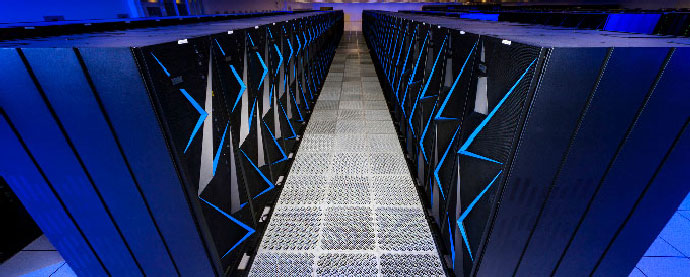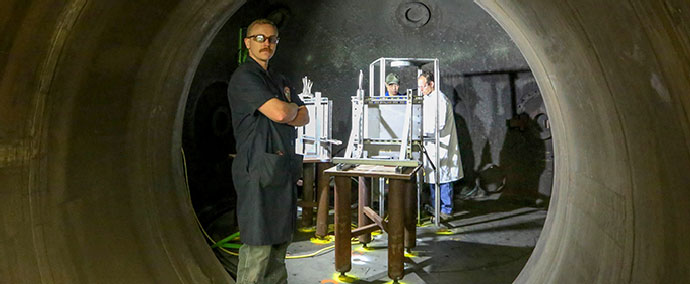Ensuring the safety, security, and effectiveness of the enduring stockpile
LLNL’s foremost responsibility is to ensure the performance of the nation’s nuclear arsenal. The knowledge gained through theory, simulations, and experiments is utilized by weapons experts to assess the condition of stockpile weapons and to develop and certify needed modifications with confidence in the absence of additional nuclear tests.
Annual Stockpile Assessment
In FY 2018, LLNL completed Cycle 23 of the annual stockpile assessment. The process included a formal comprehensive peer review by the nuclear design laboratories (Livermore and Los Alamos) of each other’s weapons systems. LLNL scientists continue to enhance the physics and engineering simulation codes that support the annual assessments and certification of weapons. Emphasis is on better scientific understanding and improved predictability and uncertainty quantification. In support of Cycle 23, LLNL completed all assigned milestones for weapons surveillance activities and special studies for the B83, W80, and W87 stockpile systems.
Life Extension of the W80 Warhead
LLNL is partnered with Sandia National Laboratories as the design agencies to develop and certify the W80-4 warhead for the bomber-delivered Long-Range Standoff (LRSO) missile. The Laboratory is making excellent progress in the W80-4 life-extension program (LEP), which entered into Phase 6.2A (design definition and cost study) in October 2017. An important aspect of the LEP is adapting the refurbished warhead to the LRSO missile, which has required close cooperation with the U.S. Air Force and contractors competing for the design of the missile. Working with the NNSA production plants, LLNL developed plans to refurbish aging components and materials in the warheads. The options include employing new manufacturing methods that minimize costs; increase throughput; and reduce the use of materials and processes that adversely affect safety, health, and the environment.
The W80-4 LEP effort requires the full array of NNSA’s computational, experimental, and manufacturing capabilities to meet all of the prototyping, proof-of-concept testing, and certification requirements. High-performance computing (HPC) resources at LLNL are used to produce extraordinarily high-resolution simulations that provide an essential computational surrogate for nuclear testing. Wide-ranging experiments at LLNL’s National Ignition Facility (NIF), the Contained Firing Facility, and the High Explosives Applications Facility (HEAF)—and at other NNSA sites—provide data to enhance confidence in computational models used for the W80-4 LEP (see below and National Ignition Facility).
Sierra Supercomputer in Operation
In October 2018, NNSA, LLNL, and industry partners officially unveiled Sierra at a dedication ceremony to celebrate completion of this IBM/ NVIDIA supercomputer. Sierra has reached a speed of 94.6 petaflops (quadrillion floating-point operations per second) in a benchmark test, placing it as the world’s second fastest supercomputer on the TOP500 List. It serves the NNSA’s three nuclear security laboratories in support of the Stockpile Stewardship Program.
This latest machine for the NNSA Advanced Simulation and Computing (ASC) program makes possible higher fidelity, more predictive simulations of weapons performance, and it provides the ability to run large 3D or higher fidelity 2D ensembles of simulations to quantify uncertainties in predictions. Sierra can process crucial 3D simulations up to 10 times faster than prior ASC computers. The machine will be heavily used to develop and certify the W80-4 warhead.
Sierra achieves its enormous speed (a peak performance of 125 petaflops) by using NVIDIA graphics processor units together with IBM central processing units in a heterogeneous architecture. Its arrival represents years of procurement, design, code development, and installation efforts carried out through the CORAL (Collaboration of Oak Ridge, Argonne, and Lawrence Livermore national laboratories) partnership. LLNL has also taken delivery of Lassen, a one-sixth-sized Sierra supercomputer, for unclassified work. DOE’s CORAL-2 is underway to procure two exascale (1,000 petaflop) machines. One of them, El Capitan, will be sited at Livermore (see Managing for the Future).
Stockpile Stewardship Experiments
LLNL successfully executed its work in the FY 2018 National Hydrodynamic Test Plan. Experiments supported campaigns to improve understanding of critical weapons science issues, assessments of the current stockpile, stockpile modernization, and programmatic efforts in nonproliferation and counterterrorism. Of particular note, Livermore executed four hydrodynamic tests (two for the W80-4 and others for the B61-12 and the W88 ALT) supporting active NNSA LEPs and weapon alteration programs. The Laboratory also conducted hydrodynamic tests to prepare for fielding subcritical experiments at the Nevada National Security Site that will collect important data about how a plutonium weapon core implodes. Many more experimental activities are underway at HEAF and LLNL’s remotely located Site 300 to qualify and remanufacture additional insensitive high explosives to be used in the refurbished W80-4 warheads.
Experiments at the Joint Actinide Shock Physics Experimental Research (JASPER) Facility and NIF (see National Ignition Facility) provide essential data about plutonium and other materials at the extreme conditions reached in a nuclear weapon. Experiments at JASPER in FY 2018 collected critically needed data about shock-compressed plutonium.







